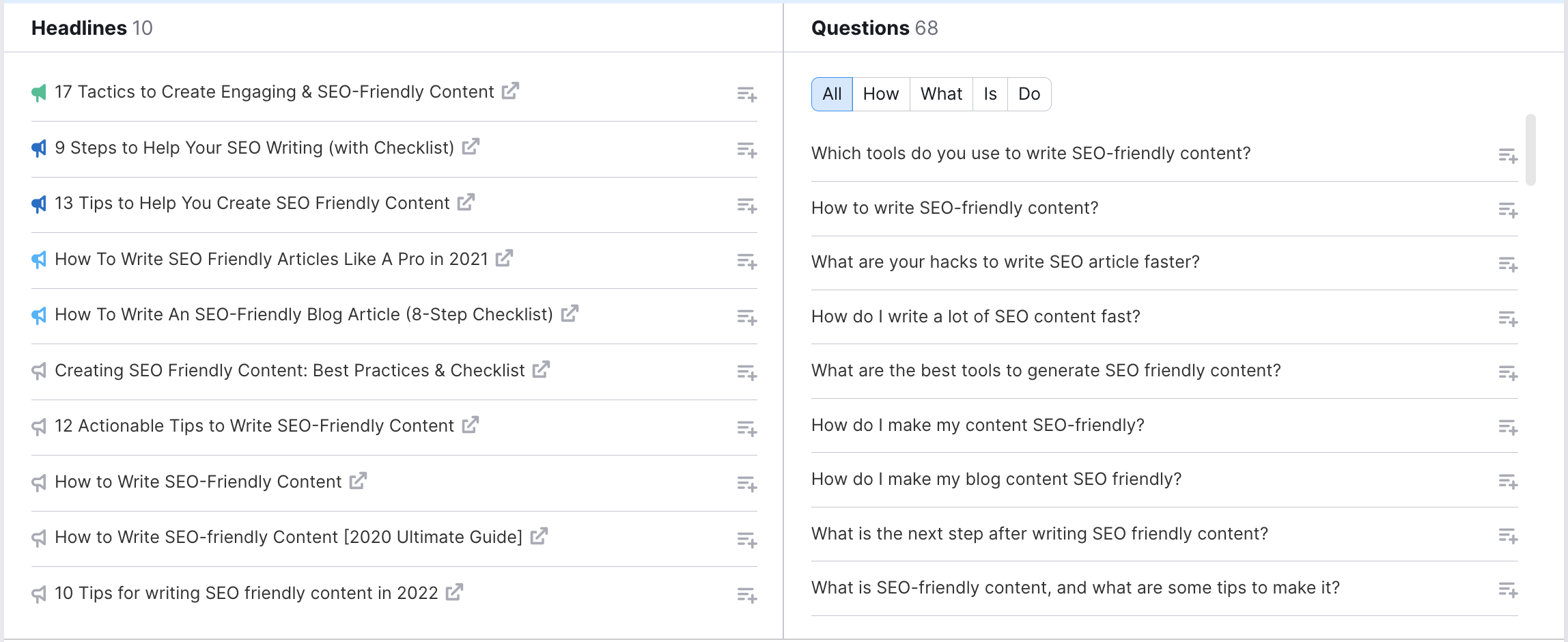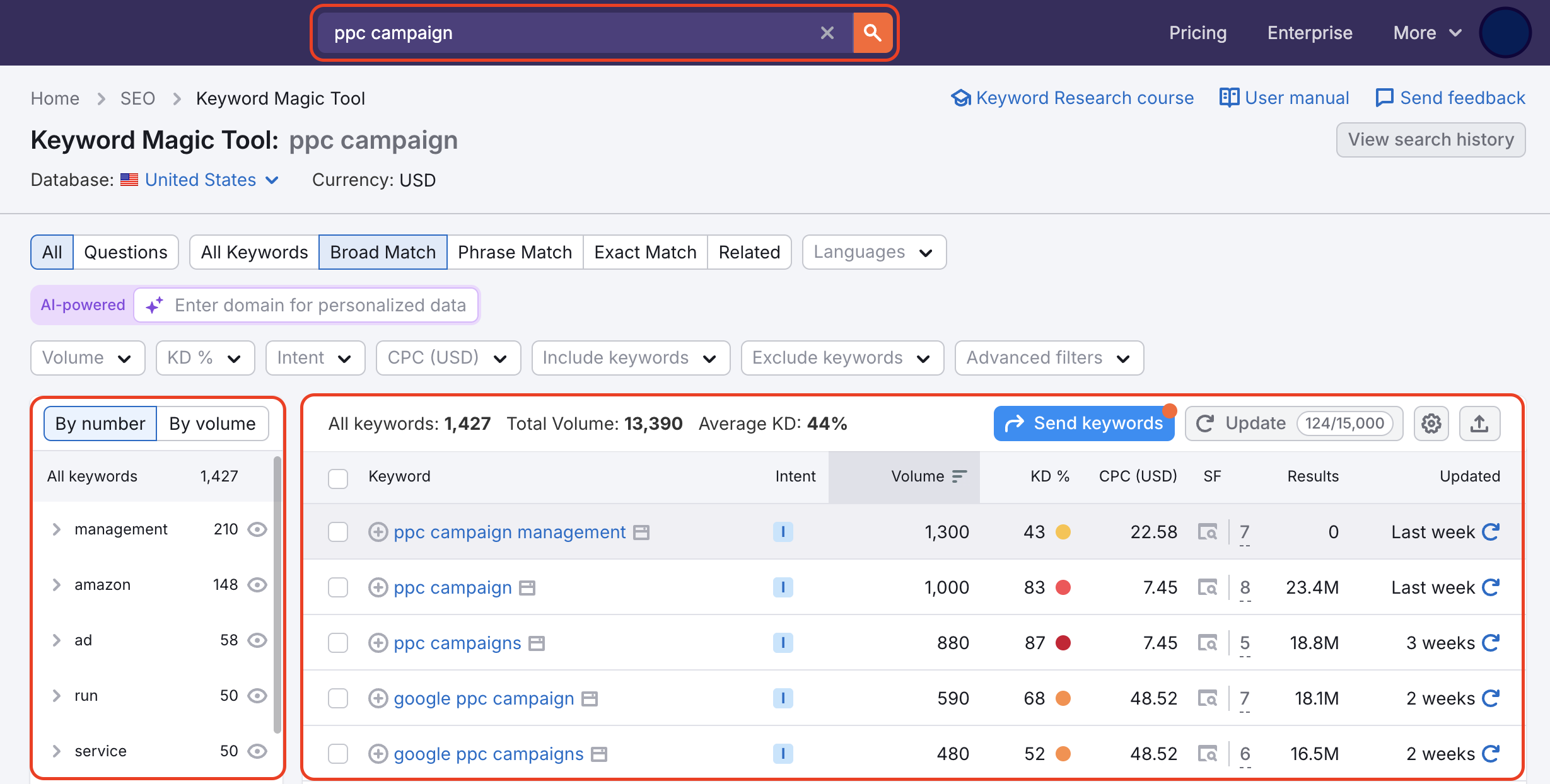Redactar contenidos eficaces es uno de los pilares esenciales del SEO. Pero como con todo en la vida, la calidad lleva un proceso. Pero hoy estás de suerte, porque te traemos los cuatro pasos que necesitarás para aplicar las herramientas de contenido de Semrush.
Este flujo de trabajo te mostrará cómo llevar a cabo la investigación, esbozar tu artículo, redactar el contenido y revisarlo para que funcione para SEO.
Nota: Las herramientas Ideas de contenido incluidas en el kit de herramientas de SEO (SEO Writing Assistant, Topic Research y SEO Content Template) solo están disponibles en los niveles de suscripción Guru y Business.
1. Reúne información en Topic Research y en la herramienta Keyword Magic Tool
Una idea no es más que una nueva combinación de dos o más elementos existentes, así que si quieres nuevas ideas, puedes empezar investigando lo que ya existe.
La herramienta Topic Research te mostrará todos los titulares existentes y las preguntas que la gente hace a Google relacionadas con tu tema de interés, para que puedas hacerte una idea de lo que hay disponible y encontrar nuevas ideas. Sólo tienes que introducir una palabra o frase en la barra de búsqueda y Semrush generará tus tarjetas temáticas.
Puedes ordenar y filtrar estas tarjetas para buscar preguntas, temas en tendencia, temas del sitio web de un competidor concreto y mucho más.

Si encuentras un tema sobre el que quieras escribir, ¡no te quedes ahí!
Guarda todo lo que te guste en tu lista de ideas favoritas. Luego, puedes volver aquí cuando necesites ideas frescas de contenido en el futuro.
La herramienta Keyword Magic Tool puede profundizar en la investigación de palabras clave. Esta herramienta reunirá todas las posibilidades de búsquedas y frases relacionadas después de que introduzcas tu consulta semilla en el campo. Después de introducir una palabra o frase objetivo, esta herramienta te devolverá una lista enorme de palabras clave relacionadas, agrupadas en sublistas para que puedas explorar todas las entidades relacionadas con tu tema.

Una parte fundamental del contenido optimizado para SEO es que los títulos y encabezados de las páginas coincidan con las palabras clave a las que te dirijas. Así que echa un vistazo al informe de Keyword Magic Tool y comprueba si puedes identificar algunas palabras clave que podrías utilizar para definir la estructura de una entrada de blog o una página web.
2. Analiza las palabras clave en función de su dificultad
La dificultad de palabra clave es la métrica patentada de Semrush que evalúa cuánta competencia existe actualmente para una palabra clave objetivo, permitiéndote seleccionar las palabras clave de baja competencia en las que basar tu página.
Se puede encontrar como una columna en cualquier informe de palabras clave en Semrush (se etiquetará como KD%), y hay una opción para comprobar la dificultad de las palabras clave de forma masiva en Visión general de palabras clave.

Selecciona una palabra clave principal y hasta 3-5 palabras clave/temas relacionados para utilizarlas en tu índice. Estas palabras clave adicionales pueden utilizarse como subsecciones y H2 en el cuerpo del texto, o simplemente como un punto adicional que incluir en tu página si tiene sentido hablar de ello.
Los estudios indican que Google prefiere el contenido que cubre una gran cantidad de preguntas relacionadas con un tema objetivo. Si puedes proporcionar información o respuestas a preguntas sobre un tema desde más de un ángulo, aumentará el valor de tu contenido.
3. Genera una plantilla de contenido SEO y estructura tu contenido
SEO Content Template es otra herramienta mágica de Semrush, aunque por su nombre no lo parezca. Con esta herramienta solo tienes que introducir las palabras clave a las que quieras dirigirte y Semrush te devolverá una plantilla completa para tu contenido que incluye recomendaciones sobre:
- Objetivo de número de palabras/extensión del artículo
- Palabras relacionadas semánticamente (más palabras a tener en cuenta para tu estructura/texto)
- Puntuación de legibilidad objetivo
- Dominios objetivo para la generación de enlaces
- Título de página
- Metadescripción
- Uso de palabras clave objetivo en los H1 y en el texto
Una vez tengas estas recomendaciones, combina estas sugerencias con tu investigación de Topic Research y Keyword Magic Tool para finalizar la estructura, calcular la extensión del texto y empezar a escribir.
4. Valora la calidad de tu artículo según lo escribes con SEO Writing Assistant
Mientras escribes tu contenido optimizado para SEO, puedes comprobar si el artículo cumple nuestras recomendaciones con el complemento SEO Writing Assistant para Google Docs y WordPress.
Este plugin se puede añadir a tu navegador web y lo que hace básicamente es integrar la plantilla que has generado con SEO Content Template en un Documento de Google o un borrador de WordPress en tiempo real para que puedas calificar tu contenido a medida que se escribe.
El asistente de redacción proporciona un análisis más profundo sobre el registro de tu contenido, para que puedas pulirlo hasta que quede tan formal o informal como quieras. A continuación, evalúa tu adecuación a la plantilla (y cuánto has optimizado la redacción) en una escala de 10 puntos.

De esta manera, puedes esperar hasta tener el contenido totalmente a tu gusto antes de publicarlo en la web.
Esperamos que este proceso te resulte útil para tu trabajo. Aquí tienes otras herramientas que podría ser interesante consultar cuando estés optimizando una web:
Para más información, visita nuestro blog y lee Consejos para crear contenidos optimizados para SEO.